Four cylinders better
Page 29
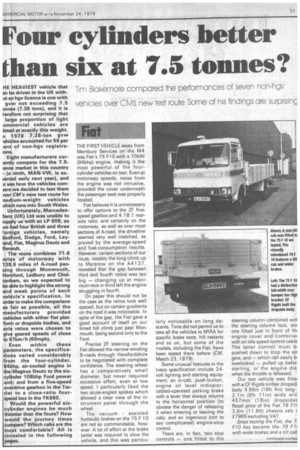
Page 30

Page 31

Page 32
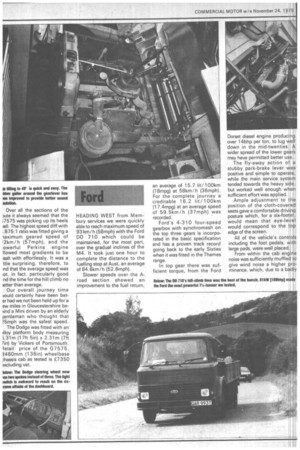
Page 33
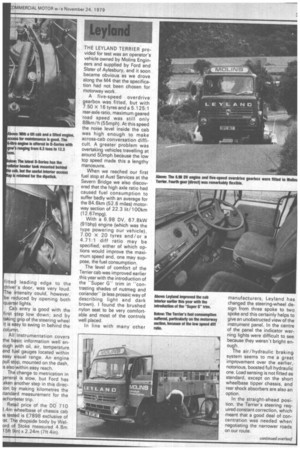
Page 34
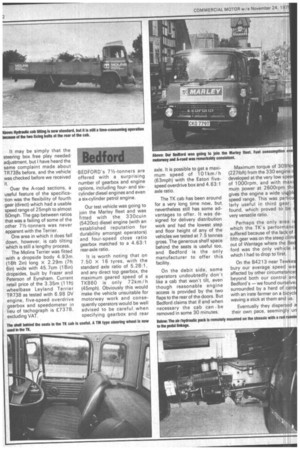
Page 35
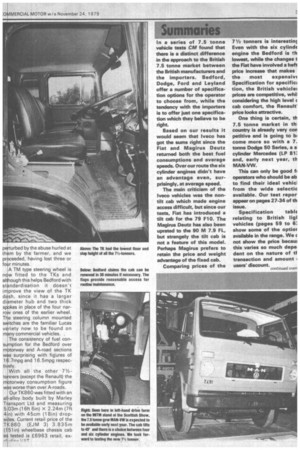
If you've noticed an error in this article please click here to report it so we can fix it.
than six at 7.5 tonnes?
Tim Blakemore compared the performances of seven non-hgv vehicles over CMS new test rout,. Some of his findings are surorisinc
HE HEAVIEST vehicle that an be driven in the UK withut ai hgv licence is one with gvW not exceeding 7.5 DInnOs (7.38 tons), and it is Marefore not surprising that large proportion of light ominercial vehicles are Ilated at exactly this weight. 1978 7.38-ton gvw 'elti les accounted for 56 per .ent of non-hgv registraions
Eight manufacturers curent y compete for the 7.5on market in this country (a ninth, MAN-VW, is axectéd early next year), and o se how the vehicles corntare we decided to test them we CM'S new test route for ne ium-weight vehicles evhi h runs into South Wales.
U fortunately, Mercedes3en (UK) Ltd was unable to iupply us with an LP 809, so Are had four British and three Foreign vehicles, namely Bedford, Dodge, Ford, Leyland, Fiat, Magirus Deutz and Renault.
The route combines 71.6 miles of motorway with 138.6 miles of A-road passing through Monmouth, Hereford, Ledbury and Cheltenham, so we expected to be able to highlight the strong and weak points of each vehicle's specification. In ord r to make the comparison as fair as possible, all the ma ufacturers provided veh cies with either flat platforri or dropside bodies, and axle ratios were chosen to give geared speeds of close to 7km/h (60mph).
Even within these par meters, the specificatio s varied considerably fron the four-cylinder, 84 hp, air-cooled engine in thai Magirus Deutz to the sixcyl der 108bhp Ford power uni ; and from a five-speed ovrdrive gearbox in the Terrie to a close-ratio fourspeed box in the TK860. Would the powerful sixcylinder engines be much thitstier than the fours? How wduld the journey times compare? Which cabs are the most comfortable? All is revealed in the following ages. THE FIRST VEHICLE away from Membury Services on the M4 was Fiat's 75 Fl 0 with a 70k1A/, (94bhp) engine, making it the most powerful of the fourcylinder vehicles on test. Even at motorway speeds, noise from the engine was not intrusive, provided the cover underneath the passenger seat was properly located.
Fiat believes it is unnecessary to offer options to the ZF fivespeed gearbox and 4.18:1 rearaxle ratio; and certainly on the motorway, as well as over most sections of A-road, the driveline seemed very well matched, as proved by the average-speed and fuel-consumption results. However, certain sections of our route, notably the long climb up to Marstow on the A4137, revealed that the gap between third and fourth ratios was too big — changing up at maximum revs in third left the engine struggling in fourth.
On paper this should not be the case as the ratios look well spaced, but on certain gradients on the road it was noticeable. In spite of the gap, the Fiat gave a good account of itself on our timed hill climb just past Monmouth, being second only to the Ford.
Precise ZF steering on the Fiat allowed the narrow winding B-roads through Herefordshire to be negotiated with complete confidence. The steering wheel has a comparatively small diameter, but never required excessive effort, even at low speed. I particularly liked the two acute-angled spokes which allowed a clear view of the instrument panel through the wheel.
The vacuum assisted hydraulic brakes on the 75 F 10 are not so commendable, however. A lot of effort at the brake pedal was required to slow the vehicle, and this was particu
larly noticeable on long descents. Time did not permit us to take all the vehicles to MIRA for specific brake tests, hill restarts and so on, but some of the models, including the Fiat, have been tested there before (CM, March 23, 1979).
Some unusual features in the lveco specification include 24volt lighting and starting equipment; an in-cab, push-button, engine oil level indicator; cabled-operated parking brake with a lever that always returns to the horizontal position (to obviate the danger of releasing it when entering or leaving the cab); and an ingenious (not to say complicated) engine-stop control.
There are, in fact, two stop controls — one fitted to the
steering column combined witl the steering column lock, an one fitted just in front of tht engine cover and combine( with an idle-speed control cable The latter control must bi pushed down to stop the en gine, and — which can easily ID, overlooked — pulled up befon starting, or the engine die when the throttle is released.
Our test vehicle was fittei with a CF Rigids timber dropsid body 4.98m (16ft 4in) long 2.1m (6ft 11 in) wide witl 457mm (18in) dropsides Retail price of the Fiat 79 F1( 3.6m (11.8ft) chassis cab i £7965 excluding VAT.
Since testing the Fiat, the 7, F10 has become the 79 F1 with wider brakes .and a tilt cab
OUR SECOND 71/2-tonner was the latest to appear on the British market — Renault's JK75. In contrast to the JN75, a derated 9-tormer with a sixcylinder 93kW (125bhp) engine which has been available since October 1976, the JK75 has a four-cylinder, 3590cc engine producing 64kW (86bhp) at 3000 rpm and is designed principally for urban distribution. The JN75, however, is intended for high-performance trunking.
The comparatively low power output of the Renault engine didn't prove to be a handicap over our test route, and even though the net installed torque of 233Nm (172 lb/ft) at 1680rpm was the lowest of the vehicles on test, the time of 3 min 36.5 sec for the hill climb was quite respectable.
This must be due to the wellchosen ratios of the ZF fivespeed gearbox which are well matched to the engine's characteristics and the 4.55:1 rearaxle ratio. On occasions the ratio gap between third and fourth seemed a little too big, but never caused any serious problems.
Liberal use of the gearbox was encouraged by the excellent gearchange — the short gearlever was perfectly positioned for me and made precise positive gearchanges easy. The parking brakes lever between the seats (controlling spring parking brakes) I found to be equally well placed, allowing the driver complete control on hill starts without shifting position in the seat at all.
Many of the features of the Renault cab attract the use of superlatives: it was certainly the most comfortable of the 7.5tonne vehicles we tested. Particularly worthy of mention, I think, is the excellent all-round vision provided by a deep wide windscreen, side windows to the rear of the doors, and two windows in the rear of the cab.
I was also impressed by the dashboard-mounted stalk which -eally did provide "finger-tip control'' over the non selfcancelling indicators (these could have been further mproved by a more clearly audible warning), and the comprehensive instrument panel in3luding a useful tachometer.
The stalk control for wipers/ washers is also dashboard -nounted, but smaller than the ndicator control and not so easy o reach, I found the two wiper ilades to be too small for the.. arcie windscreen area: three blades would be better. Switching on side or headlights was a fussy operation, the rocker switch controlling the lights being, in my opinion, far too small and poorly sited on the dashboard.
Over Aand B-roads the handling of the JK75 was good; it felt more like a big car than a small truck, with effective antiroll bars fitted to the front and rear as standard. Noise level at 64km/h (40mph) was low, as one would expect, but at 97km / h (60mph) it rose quite a bit and it was obvious that the small engine, turning at 3000 rpm at that road speed, was
working quite hard.
Cab tilting could not be easier with just one lever to lock and unlock, and a useful indicator light on the dashboard to warn if the cab is not properly located. There's a lot of space for working around the engine with the cab tilted, but number four injector looks as if it may be a bit difficult to reach because of the cross member just above it.
The Renault was fitted with a Ken Rosebury dropside body 4.60m (15ft lin) long x 2.31m (7ft 7in) wide with 432mm (17in) dropsides. Retail price of the 3.25m (10.66ft) chassis cab is £7185.
THE CLEAR SKIES and higt temperatures of the first twc days of the test continued for th( third and for the only air-coolec 7. 5 tonner —the Magirus Deutz Apart from the engine, the chassis-cab of the -Maggie" virtually identical to that of the Fiat (both companies beinc members of lveco).
The four-cylinder four-stroke engine produces 62. 50,Ai (83.8bhp) from a capacity ol 4086cc (249.3cu.in). A belt drivenaxial blower provides the engine with cooling air which is ducted around the individually replaceable cylinder barrels and heads.
In the event of any failure in the cooling system, adequate warning is provided in the cab by a cylinder-head temperature gauge as well as an oiltemperature warning light and a light and buzzer that operates if the fan drive fails.
There's no hot water around the engine, so something else has to be used for the cab heater and Magirus chooses to use engine oil. The idea is certainly unconventional but we are assured that it works well. I still wonder how long the cab takes to warm up on a really cold morning.
As with the Fiat, no options are offered to the rear-axle ratio and five-speed gearbox but, because of the different characteristics of the Deutz engine, the ratios used in both gearbox and axle are not the same as the Fiat's.
The 4.5:1 diff ratio gave a maximum road speed of just, short of 97km/h (60mph), yet' on the first 52 miles of motorway section, the Magirus was only three minutes slower than its longer-legged Italian brother.
I was expecting to have to use the gearbox a lot on the hills of our test route since the power-to-weight ratio of 8.3kW/tonne (11.3bhp /ton) was the lowest of the vehicles on test but, in fact, the hill climbing ability was surprisingly good. Some advice from the Magirus Deutz demonstration driver helped here because, to someone unused to the sound of the air-cooled engine and with no rev-counter, it was easy to change down too early.
Maximum torque of 251Nm (185 lbft) is developed at 1600rpm, but the torque curve is very flat between 1400rpm and 1900rpm and torque does nol drop below 249.5Nm (184 lb ft) between those engine speeds. This meant that it was possible to hang on in fourth on sotne gradients where I thought Third would be needed.
Our test vehicle was fitted with a driver's suspension seat which, we are told, is now a standard fitment. Many cost-co scious operators may believe th t this is an unnecessary luxury in a vehicle of this size, but I was grateful for the level of comfort it provided and I'm sure ma y drivers would argue that th extra cost is worthwhile.
he handle in the cab roof jus above the dual passenger sea is handy for a passenger to hol on to, but it is primarily int nded to hold up the pa enger seat when it is hinged up ards to give access to the encine. Neither of the lveco vehicles has a tilt cab and getting at the engine is difficult on both, but the Magirus is probably worse from a fitter's point of view because of the tin shrouds for the air cooling. Of course, the argu; ment is that an air-cooled engine should need less maintenance anyway but that is hardly justification for hiding it away.
The 3600mm (11.8ft) wheelbase 90M 7.5 FL was fitted with a dropsicie body measuring 4.88m (16ft) x 2.31m (7ft 7in) by Collier and Sons Ltd of Essex. Retail price of the Magirus Deutz chassis cab is £7690 excluding vat. DODGE's 100-Series "Commando" range includes chassis with gross weights ranging from 7.5 tonnes to 20 tonnes (plus a recently introduced 26.5 tonnes .gcw tractive unit), so the G08 71/2-tonner is the "baby" of the range. The standard power unit is a Perkins 4.236 four-cylinder, diesel, but most operators choose the six-cylinder 75.8 kW (101.7bhp) option and this indeed was the engine in our test vehicle, driving through a fourspeed gearbox. A five-speed gearbox and two-speed axle are available as options. Access to the driver's sr
pension seat ("Hi-lin( specification for the cab is n( standard) is easy, even thou, the Commando has a comr ratively high cab-floor height 940mm (37in). I liked the hi! driving position which col bined with the deep windscre to give first-c;ass forwa visibility. Rearward visii wasn't a problem either, with large window in the centre of ti rear of the cab and smaller on each side of it.
At low speeds the steerii felt heavy, perhaps because the combination of a relativs low ratio in the steering box 24:1, and 8.25 x 16 tyres place of the 7.50-16 fitted standard at 7.5 tonnes gvw I all other British manufacturers
The smaller tyres are fitted the Dodge when the fou cylinder Perkins engine is use but specifying the heavi, 6.534 makes the larger tyrt mandatory and gives the fro axle a plated weight of 3.2 tonnes (3.2 tons) — more thE most of the competition.
As a result of criticisms , early vehicles, Dodge hi improved a number of items the cab including heater outpu gearlever rubber gaiter (I improve noise insulation), doi locks, and window fittings. think there is room for furthi improvement to tb gearchange, which required good deal of effort and coul prove a source of annoyance 1 an urban-delivery driver.
It was also slightly annoyin to have to reach forward to tF
extreme offside of the dast board for the rocker-switch col trolling lights; it must be po: sible to find a more convenier .location for it.
Over all the sections of the )ute it always seemed that the i7575 was picking up its heels tell. The highest speed diff with .875:1 ratio was fitted giving a laximum geared speed of 12km/h (57mph), and the owerful Perkins engine Hawed most gradients to be ealt with effortlessly. It was a ttle surprising, therefore, to nd that the average speed was lot, in fact, particularly good nd the time for the hill climb no letter than average.
Our overall journey time vould certainly have been beter had we not been held up for a• ew miles in Gloucestershire beiind a Mini driven by an elderly jentleman who thought that ?5mph was the safest speed.
The Dodge was fitted with an illoy platform body measuring 5.31m (17ft 5in) x 2.31m (7ft lin) by Vickers of Portsmouth. letail price of the G7575, 3460mm (136in) wheelbase ;hassis cab as tested is £7350 )xcluding vat. HEADING WEST from Membury services we were quickly able to reach maximum speed of 93 km/h (58mph) with the Ford DO 710 which could be maintained, for the most part, over the gradual inclines of the M4. It took just one hour to complete the distance to the fuelling stop at Aust, an average of 84.6km /h (52.6rnph).
Slower speeds over the Aroad section showed an improvement to the fuel return, an average of 15.7 lit/100km (18mpg) at 58km /h (36mph). For the complete journey a creditable 16.2 lit/100km • (17.4mpg) at an average speed of 59.5km/ h (37mph) was recorded.
Ford's 4-310 four-speed gearbox with synchromesh on the top three gears is incorporated in the basic specification and has a proven track record going back to the early Sixties when it was fitted in the Thames range.
In top gear there was sufficient torque, from the Ford Dorset diesel engine producing over 14bhp per ton, to lug well down in the mid-twenties. A wider spread of the lower gears may have permitted better use.
The fly-away action of a stubby park-brake lever was positive and simple to operate, while the main service system tended towards the heavy side, but worked well enough when sufficient effort was applied.
Ample adjustment to the position of the cloth-covered seats gave a comfortable driving posture which, for a six-footer, would mean that eye-level would correspond to the top edge of the screen.
All of the vehicle's controls including the foot pedals, with large pads, were well placed.
From within the cab engine noise was sufficiently muffled to give wind noise a higher prominence, which, due to a badly fitted leading edge to the driver's door, was very loud. The intensity could, however,' be reduced by opening both quarter lights.
Cab entry is good with the first Step low down; and by taking grip of the steering wheel it is easy to swing in behind the colurrin.
Al11 instrumentation covers the b sic information well enough ith oil, air, temperature. and f el gauges located within easy isual range. An engine pull St p, mounted on the dash, is also within easy reach.
Th change to metrication in gener I is slow, but Ford has :aken nother step in this direcion b making kilometres the itanda d measurement for the acho eter trip.
Retail price of the DO 710 3.4m Wheelbase of chassis cab is tested is £7898 exclusive of 'at. The dropside body by Welord cy1 Stoke measured 4.8m 15ft 9in) x 2.24m (7ft 4in). THE LEYLAND TERRIER provided for test was an operator's vehicle owned by Molins Engineers and supplied by Ford and Slater of Aylesbury, and it soon became obvious as we drove along the M4 that the specification had not been chosen for motorway work.
A five-speed overdrive gearbox was fitted, but with 7.50>< 16 tyres and a 5.125:1 rear-axle ratio, maximum geared 'road speed was still only 88km/ h (55mph). At this speed the noise level inside the cab was high enough to make across-cab conversation difficult. A greater problem was overtaking vehicles travelling at around 50mph because the low top speed made this a lengthy manoeuvre.
When we reached our first fuel stop at Aust Services at the Severn Bridge we also discovered that the high axle ratio had caused fuel consumption to suffer badly with an average for the 84.6km (52.6 miles) motorway section of 22.3 lit/100km (12.67mpg).
With a 6.98 DV, 67.8kW (91bhp) engine (which was the type powering our vehicle), 7.00 X 20 tyres and/or a 4.71:1 diff ratio may be specified, either of which options would improve the maximum speed and, one may suppose, the fuel consumption.
The level of comfort of the Terrier cab was improved earlier this year with the introduction of the "Super G" trim in "contrasting shades of nutmeg and coriander" (a less prosaic way of describing light and dark brown). I found the brushed nylon seat to be very comfortable and most of the controls well placed.
In line with many other manufacturers, Leyland has changed the steering-wheel design from three spoke to two spoke and this certainly helps to give an unobstructed view of the instrument panel. In the centre of the panel the indicator warning lights were difficult to see because they weren't bright enough.
The air/hydraulic braking system seems to me a great improvement over the earlier, notorious, boosted full hydraulic one. Load sensing is not fitted as standard, except on the short wheelbase tipper chassis, and rear shock absorbers are also an option.
In the straight-ahead position, the Terrier's steering required constant correction, which meant that a good deal of concentration was needed when negotiating the narrower roads on our route. It may be simply that the steering box free play needed adjustment, but I have heard the same complaint made about TR738s before, and the vehicle was checked before we received it.
Over the A-road sections, a useful feature of the specification was the flexibility of fourth gear (direct) which had a usable speed range of 25mph to almost 50mph. The gap between ratios that was a failing of some of the other 71/2-tonners was never apparent with the Terrier.
One area in which it does fair down, however, is cab tilting which is still a lengthy process.
The Molins Terrier was fitted with a dropsicle body 4.93m. (16ft 2in) long X 2.29m (7ft 6in) wide with 45.7cm (18in) dropsides, built by Frazer and Peterson of Eynsham. Current retail price of the 3.35m (lift) wheelbase Leyland Terrier TR738 as tested with 6.98 DV engine, five-speed overdrive gearbox and speedometer in lieu of tachograph is £7378, excluding VAT.
Bedfor
:BEDFORD's 71/2-tonners are offered with a surprising number of gearbox and engine options, including fourand sixcylinder diesel engines and even a six-cylinder petrol engine.
Our test vehicle was going to join the Marley fleet and was fitted with the 330cuin (5420cc) diesel engine (with an established reputation for durability amongst operators) and four-speed close ratio gearbox matched to a 4.63:1 rear-axle ratio.
It is worth noting that on 7.50 X 16 tyres, with the standard axle ratio of 5.28:1, and any direct top gearbox, the maximum geared speed of a TK860 is only 72km / h (45mph). Obviously this would make the vehicle unsuitable for motorway work and consequently operators would be well advised to be careful when specifying gearbox and rear axle. It is possible to get a maximum speed of 101km /h (63mph) with the Eaton fivespeed overdrive box and 4.63:1 axle ratio.
The TK cab has been around for a very long time now, but, nevertheless still has some advantages to offer. It was designed for delivery distribution work and had the lowest step and floor height of any of the vehicles we tested at 7.5 tonnes gross. The generous shelf space behind the seats is useful too, and Bedford is the only manufacturer to offer this facility.
On the debit side, some operators undoubtedly don't like a cab that won't tilt, even though reasonable engine access is provided by the two flaps to the rear of the doors. But Bedford claims that if and when necessary the cab can be removed in some 30 minutes. Maximum torque of 309N (227Ibft) from the 330 engine developed at the very low spee of 1000rpm, and with maxi mum power at 2600rpm thi gives the engine a wide uso_bl speed range. This was particu larly useful in third gear, found, which proved to be very versatile ratio.
Perhaps the only area which the TK's performanc suffered because of the lack of fifth gear was on the steep clim out of Wantage where the Be ford was the only vehicle i which I had to drop to first.
On the B4213 near Tewke bury our average speed wa. affected by other circumstance beyond both our control an Bedford's — we found ourselve surrounded by a herd of cattl with an irate farmer on a bicycl waving a stick at them and us.
Eventually they dispersed a their own pace, seemingly un perturbed by the abuse hurled at them by the farmer, and we pro' ceeded, having lost three or four minutes.
A TM type steering wheel is now fitted to the TKs and although this helps Bedford with standardisation it doesn't improve the view of the TK dash, since it has a larger diameter hub and two thick spokes in place of the four narrow ones of the earlier wheel. The steering column mounted svitches are the familiar Lucas variety now to be found on many commercial vehicles. .
The consistency of fuel consumption for the Bedford over motorway and A-road sections was surprising with figures of 1 .7mpg and 16.5mpg respectively.
With all the other 71/2tohners (except the Renault) the motorway consumption figure w s worse than over A-roads.
Our TK860 was fitted with an al -alloy body built by Marley T ansport Ltd and measuring 503m (16ft Bin) X 2.24m (7ft 4n) with 45cm (18in) dropsi es. Current retail price of the T 860 (EJM 3) 3.835m (1 51 in) wheelbase chassis cab as tested is £6963 retail, ex
In a series of 7.5 tonne vehicle tests CM found that there is a distinct difference in the approach to the British 7.5 tonne market between the British manufacturers and the importers. Bedford, Dodge, Ford and Leyland offer a number of specification options for the operator to choose from, while the tendency with the importers is to offer just one specification which they believe to be right.
Based on our results it would seem that Iveco has got the sums right since the Fiat and Magirus Deutz returned both the best fuel consumptions and average speeds. Over our route the six cylinder engines didn't have an advantage even, surprisingly, at average speed.
The main criticism of the Ivaco vehicles was the nontilt cab which made engine access difficult, but since our tests, Fiat has introduced a tilt cab for the 79 F10. The Magirus Deutz has also been uprated to the 90 M 7.9 FL, but strangely the tilt cab is not a feature of this model. Perhaps Magirus prefers to retain the price and weight advantage of the fixed cab.
Comparing prices of the 71/2 tonners is interestint Even with the six cylinde engine the Bedford is th lowest, while the changes t the Fiat have involved a heft price increase that makes the most expensive Specification for specific4 tion, the British vehicle' prices are competitive, whil considering the high level cab comfort, the Renault' price looks attractive.
One thing is certain, th 7.5 tonne market in thi country is already very con petitive and is going to [14 come more so with a 7. tonne Dodge 50 Series, a sl cylinder Mercedes (LP 81: and, early next year, th MAN-VW.
This can only be good ft operators who should be ab to find their ideal vehicl from the wide selectic available. Our test repor appear on pages 27-34 of th issue.
Specification table relating to British ligl vehicles (pages 59 to 6: show some of the optior available in the range. We c not show the price becath this varies so much depe dent on the nature of II transaction and amount users' discount.








































































































































